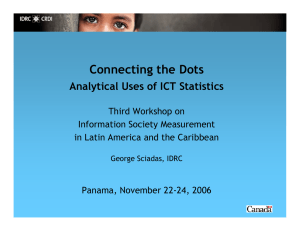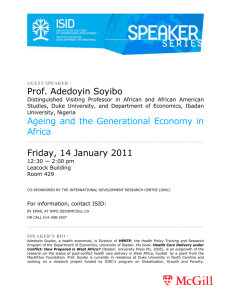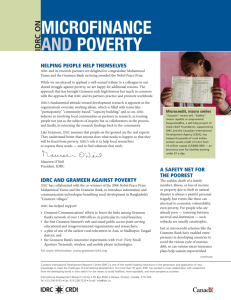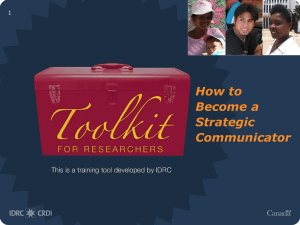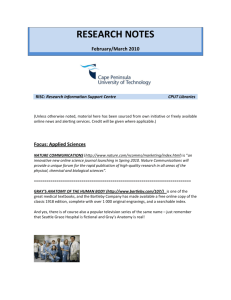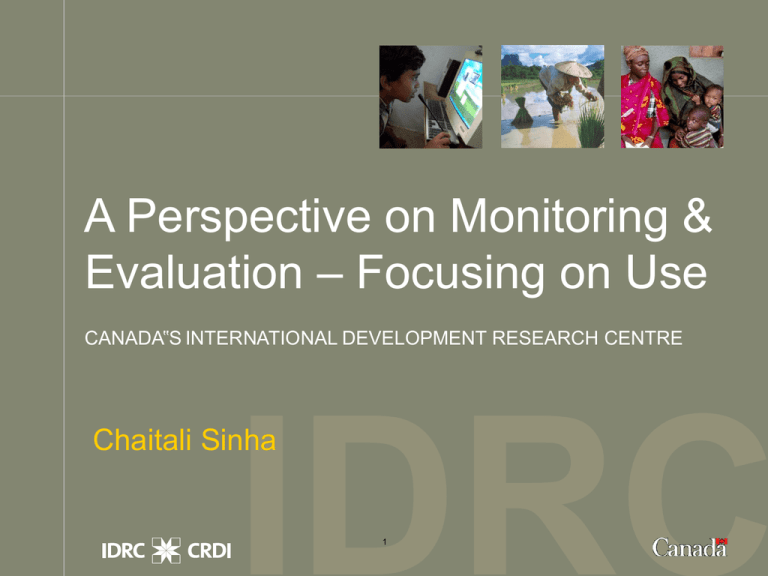
A Perspective on Monitoring &
Evaluation – Focusing on Use
CANADA‟S INTERNATIONAL DEVELOPMENT RESEARCH CENTRE
IDRC
Chaitali Sinha
1
Outline
What is IDRC?
Health Systems Research
Monitoring and Evaluation at IDRC
Utilization-Focused Evaluation (UFE)
IDRC
Developmental Evaluation (DE)
Key Evaluation Questions
Applied examples of UFE
2
What is IDRC
Canada‟s International Development Research
Centre
Created in 1970
Research grants to developing country institutions
to investigate locally relevant research issues
IDRC
Build new knowledge, research
capacity, and influence policy
and practice
www.idrc.ca
3
Ottawa, Canada
Cairo, Egypt
Dakar, Senegal
New Delhi,
India
IDRC
Nairobi, Kenya
Montevideo, Uruguay
4
Singapore
Research on Health Systems
Strengthening
IDRC
5
Systems Thinking: crucial - but not novel
• A “system” can be understood as an arrangement
of parts and their interconnections that come
together for a purpose (von Bertalanffy 1968).
• The World Health Organization (2000) redefined
the main purpose in its definition of a health
system as “all activities whose primary purpose is
to promote, restore, and maintain health.” In
recent years, the definition of “purpose” has been
further extended to include the prevention of
household poverty due to illness.
IDRC
6
Different Considerations
Services
Processes
Equity
Health
System
Governance
IDRC
Capacity Outcomes
… Why does this matter for health systems research?
7
Health Systems are Complex
Dependent on policies, activities and institutions
Rooted in people
Requires coordination
Adaptation and learning are critical
Understanding trade-offs and complementarity
IDRC
8
Research Networks
A type of complex system
Research Networks (Real & Wilson-Grau, 2008)
Adaptive Capacity
Communication
Expertise
Financial Management
Knowledge Management & Learning
Leadership
Legitimacy
Network Management/Governance
Participation
Resource Mobilization
IDRC
9
IDRC-Supported eHealth Networks
Latin America and the Caribbean: eSAC
(Public eHealth Innovation and Equity in LAC)
Africa (OASIS – Open Architectures,
Standards and Information Systems)
Asia (PANACeA – PAN Asian Collaboration for
evidence-based eHealth Adoption and
Application)
IDRC
10
eSAC: LAC region
Examining health inequities
Sensitizing multiple stakeholders on ICTs applied
to public health
E.g. Young Professionals (call for applications open)
Supportive environment and system of incentives
to promote innovation
IDRC
Managed by PAHO and the Centre for Global
eHealth (University of Toronto)
http://esacproject.net/
11
eSAC: LAC region
Diagram showing relationship of knowledge, social value, and other aspects has been removed due to copyright restrictions.
IDRC
Utilization-Focused Evaluation - DE
12
OASIS II: Africa region
Network of networks – Second phase
Building useful evidence base
Five cross-cutting areas of research
„Open‟ approach
Partners:
IDRC
Jembi (Network Leader)
PIH: Rwanda
Millennium Villages Project (MVP)
ROSA
Catalyzed and/or nurtured other networks and
initiatives
13
OASIS II: Africa region
OASIS II Framework
RQ: Research Question
RD: Research Design
Phase 2:
Apply in other
projects
Phase 1:
Aggregate, Analyze
and Share
OASIS II Methodology
Constant Phase
Publish
Crosscutting Research
ICT/Health
Integration
Local
Capacity
Health
Outcomes
Collaboration/
Process
Interoperability
Analysis
RQ
1
RD
RQ
1
RD
RQ
1
RD
RQ
1
RD
RQ
1
RD
IDRC
n
ROSA
RD
RQ
n
RD
OASIS-Core
C. Sinha 2008
14
Utilization-Focused Evaluation
RQ
……….
OpenArch
RQ
.
……….
RD
……….
n
……….
RQ
.
……….
MVP
RD
.
……….
n
……….
RQ
.
……….
RD
.
1
……….
PIH
n
RQ
……….
RQ
……….
……….
.
RD
n
RHEIN
RD
PANACeA: Asia region
12 countries in Asia
Multi-country research studies
Mentoring scheme
Cross-cutting thematic areas
Social and gender analysis
Outcomes
FOSS
Systematic reviews
Policy
Communications
…
IDRC
http://panacea-ehealth.net/
15
PANACeA: Asia region (1 of 2)
Diagram showing projects and project partners removed due to copyright restrictions.
IDRC
16
Pause …
IDRC
… we will come back to health systems shortly
17
… stay tuned
IDRC-Monitoring & Evaluation
IDRC
18
Purposes of Evaluation
Accountability
Learning
IDRC
19
International Standards of
Evaluation Quality
Utility
Feasibility
Accuracy
Propriety
IDRC
20
Monitoring
Evaluation
Ongoing throughout
project/program lifecycle
Episodic and time bound
Internal activity
Can be internal,
often external
Continuous feedback to
improve project & report on
performance
Periodic feedback –
summative, formative or
developmental
IDRC
21
Key Evaluation Challenges
Clarifying values
Encouraging iterative learning
Establishing cause & effect (or correlations)
in an open system
Measuring development results of research
Timing
IDRC
22
Utilization-Focused Evaluation
IDRC
23
Utilization Focused Evaluation
Goal:
Intended Use(s)
by
IDRC
Intended User(s)
24
Focus of UFE
evaluative purpose (formative, summative,
developmental)
type of data (quantitative, qualitative, mixed)
design (naturalistic, experimental),
and focus of the evaluation
(processes, outcomes, impacts,
cost-benefit, etc.)
Image of book, Utilization-Focused Evaluation by Michael
Quinn Patton, removed due to copyright restrictions.
25
Choosing Methods and Approaches
IDRC
26
UFE Traps & Temptations (1 or 2)
Evaluators make themselves the primary
intended users
Identify vague, passive audiences as users
Targeting organizations as users
Assuming the evaluation’s funder is the
primary stakeholder
IDRC
27
UFE Traps & Temptations (2 of 2)
Waiting until the findings are in to identify
intended users and intended uses
Taking a stance of standing above the
messiness of people and politics
Being co-opted by powerful stakeholders
IDRC
Identifying primary intended users but not
involving them meaningfully
(Patton, 2008, adapted from p. 90 - Ch.3)
28
Examples of UFE Methodologies
Outcome Mapping
Most Significant Change
Gender Evaluation Methodology
Image of book Outcome Mapping by Sarah Earl, Fred Carden, and
Terry Smutylo, and image of gender evaluation methodology from
APC.org, have been removed due to copyright restrictions.
IDRC
29
Key Evaluation Questions
IDRC
30
Some different types of KEQs
Impact
Outcomes
Approach/ model
Process
Quality
IDRC
Cost effectiveness
31
* Slides on KEQ‟s draw heavily on work of J. Dart
Some different types of KEQs
Impact
To what extent is it likely that the
desired practice change will lead to
improvement in the STATE (e.g. less
poverty, reduced mortality, improved
water quality).
IDRC
32
Some different types of KEQs
Outcomes
To what extent did participating farmers
change their PRACTICES around
fertiliser management?
IDRC
33
Some different types of KEQs
Approach/ model
How does our model of engagement
and strengthening capacities compare
with others? (comparative study)
IDRC
34
Some different types of KEQs
Process
To what extent were partners
adequately engaged during the project
development process?
IDRC
35
Some different types of KEQs
Quality
To what extent did the quality of the
research/research outputs adhere to
acceptable standards for policy papers?
IDRC
36
Some different types of KEQs
Cost effectiveness
To what extent were the predicted costs
balanced with the effectiveness of the
intervention?
IDRC
37
What makes good KEQs?
Specific enough to be useful in guiding you through
the evaluation
Broad enough to be broken down - are not the same
as a question in a survey
Data (qual/quant) can be brought to bear on KEQs
KEQs are open questions (can‟t answer yes or no!)
IDRC
Lead to useful and credible findings
There aren‟t too many of them! Eg 2-4 is good!
38
Developmental Evaluation
IDRC
39
M&E in the Real World
IDRC
© Michael Quinn Patton. All rights reserved. This content is excluded from our
Creative Commons license. For more information, see http://ocw.mit.edu/fairuse.
Patton 2011 – Building on Ralph
Stacey's Agreement & Certainty Matrix
40
© Cynthia Kurtz and Dave Snowden. All rights reserved.
This content is excluded from our Creative Commons license.
For more information, see http://ocw.mit.edu/fairuse.
Cynefin Framework (Kurtz &
Snowden, 2003)
Developmental Evaluation
• Supports the process of innovation
• State of continuous development and adaptation
• Unfolding in a changing and unpredictable environment.
• Much is in flux: the framing of the issue can change, how
the problem is conceptualized evolves
IDRC
• Adaptations are largely driven by new learning and by
changes in participants, partners and context.
McConnel Foundation (2008)
41
When is it Appropriate to use DE?
Early Design: when an intervention design or model is being
developed from scratch through prototyping and
experimentation.
Radical Program Redesign: when an existing program is being
significantly redesigned to reflect large scale and/or rapid
changes in context
Program Replication: when a program that has proved to work
in context is being replicated in another context where the
design must be substantially restructured to reflect the realities
of that new context.
IDRC
Complex Issues: where the dynamics of the problem are poorly
understood, possible solutions are unclear, and intervention
stakeholders are not aligned (e.g. a plan to end homelessness)..
Crisis: where evaluative thinking is required to inform fast
paced and decisive decisions (e.g. relief efforts after an earth
quake).
42
Developmental
Evaluation
Screenshots of books removed due to copyright restrictions.
The DE Primer.
Michael Quinn Patton
IDRC
Jamie Gamble.
http://www.imprintinc.ca/
Getting to Maybe.
43
Frances Westley
Brenda Zimmerman
Michael Quinn Patton
Play …
IDRC
… we now come back to health systems
… some examples
44
UFE: OASIS II and PANACeA
IDRC
45
UFE: OASIS II
Intended Users: four project leaders in the
network
Intended Uses: being discussed
Proposed areas: Capacity Building and
Interoperability (TBC)
IDRC
46
UFE: PANACeA
Diagram showing structure of PANACeA formative network evaluation has been removed due to copyright restrictions.
IDRC
47
Developmental Evaluation
example: eSAC
IDRC
48
Developmental Evaluation: eSAC
Intended Users: being discussed (likely project
leaders)
Intended Uses: being discussed
A DE facilitator is working alongside the eSAC
team from the beginning of the project
IDRC
49
Why would poor people need ICTs?
IDRC
Photo: IDRC
50
Development is not a zero-sum game
IDRC
Photo: IDRC
51
Requires an understanding of systems
Photo of women and children removed due to copyright restrictions.
IDRC
52
Thank you
Chaitali Sinha
Program Officer
Governance, Equity and Health (GEH)
International Development Research Centre
IDRC
53
MIT OpenCourseWare
http://ocw.mit.edu
HST.S14 Health Information Systems to Improve Quality of Care in Resource-Poor Settings
Spring 2012
For information about citing these materials or our Terms of Use, visit: http://ocw.mit.edu/terms.

